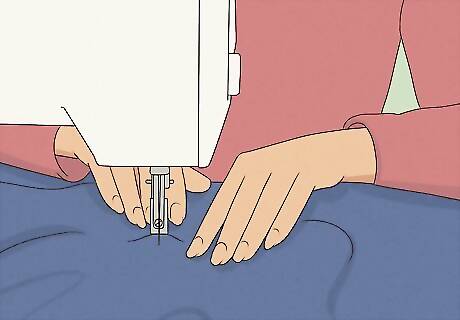
views
Education

Earn a high school diploma. There are no official educational requirements for becoming a tailor. As a general rule, though, you should at least have a high school diploma or GED, especially if you intend to work as a tailor for a larger fashion company. Check with your high school to see if there are any classes that might prove relevant to the field. At the very least, you should try to take a home economics course. Some high schools may even have more in-depth sewing courses that can teach you about fashion design, hand sewing, and industrial power sewing. Take art electives to help you develop a better aesthetic taste so that you will be more prepared to work with color and style. Make sure that your classes also help you maintain basic math skills so that you will have no problem working with measurements. A business class or two can also help if you plan on becoming a self-employed tailor. Work-study courses can be beneficial, too, since the instructor might be able to help you land work with someone in the fashion industry.

Take college level courses. Even though you do not need to have a college degree, you can benefit from taking college classes about fashion and design. In addition to being beneficial for your own improvement, having college coursework or a college degree might make your employer more likely to consider you for higher level jobs. You may even work your way up the chain and be placed in charge of other tailors as a supervisor. Check with local community colleges and technical schools since they are more likely to have sewing, design, and fashion courses than four-year liberal arts colleges. The classes at a community college or technical school will also be cheaper. Look for schools that offer a variety of courses at the beginner, intermediate, and advanced levels. Study matters related to clothing construction, patterns, textiles or fabrics, finishes, detailing, and fit. Ideally, your classes should provide you with textbook information and plenty of practice sewing exercises.

Consider taking business classes. Many tailors end up being self-employed. While it is not strictly necessary, you might find it beneficial to take a few business and business finance courses at the college level to prepare you for the responsibilities and duties involved in running your own business. Look for business classes at community colleges in your area. Pay close attention to general business classes, business finance classes, entrepreneurship classes, marketing classes, and any other class dealing with small business topics.
Experience

Work as an apprentice. One of the best things you can do to prepare yourself for work as a professional tailor is to take an apprenticeship under a tailor who is already established in the business. An apprenticeship will train you in the skills you need to enter the business, and the experience will look good on your resume or CV. You might be able to find an apprenticeship program working with an alteration tailor, custom tailor, or shop tailor. An official alteration tailor apprenticeship will consist of roughly 4000 hours of work, while apprentices to custom tailors and shop tailors will complete roughly 8000 hours. The tailor you apprentice under will start you with simple tasks related to sewing, mending, and altering garments. As you demonstrate skill and understanding, you will be given more complex tasks.

Opt for informal training, if necessary. Since actual apprenticeships can be difficult to come by, you can also obtain a little training simply by working with a tailor or in an alterations department doing tasks that are not directly related to the work of the tailor. If you cannot land an official apprenticeship, try to get hired part-time in an alterations department at a clothing store or other similar workplace. Even if you do nothing but answer phones, tidy up, and schedule appointments, you will at least gain knowledge about the atmosphere you can expect to work in as well as any essential terminology or concepts.

Practice retail work. A tailor will need to work with the public, so practicing your salesmanship and customer service will be beneficial to you in the long-run. Moreover, having retail work experience could actually look good on your resume or CV if you decide to apply for a job with a professional tailor or alterations department. You need to develop communication and interpersonal skills so that customers will feel comfortable with you as you take measurements and discuss the best ways to improve their garments. While all retail work will give you some experience working with the public, some jobs are better than others. Part-time jobs in department stores, clothing stores, shoe stores, stores specializing in accessories are preferable to fast food or sit-down restaurant work. Store jobs, especially those just mentioned, will get you accustomed to the fashion retail setting instead of any generic retail setting. On the other hand, jobs at pet stores, convenient stores, and grocery stores have nothing to do with the industry and therefore are not as ideal.

Refine your skills on your own. Official, professional training helps, but if you want to become an excellent tailor, you will need to practice on your own time, as well. If you plan on being self-employed, self-training might even be enough to get you started. You can browse around at a book store for manuals that can teach you new sewing techniques or more information about fabric types, fashion design, and other topics related to the field. You can also look for video demonstrations online to learn about different sewing techniques if you need more precise, step-by-step examples to follow.

Train with the tools of the trade. No matter how you choose to get your training and work experience in before you start your career as a tailor, you should make sure that you have plenty experience with the actual tools used in that line of work. You must be proficient in using a standard cloth measuring tape as well as other measuring instruments. Measuring tape is usually used for body measurements, but a short ruler is usually used for buttonhole spacing and hem lengths. French curve rulers help tailors work with angled seam lines. You also need to work with professional level sewing machines and sergers. Learning when use different settings on these machines, different needle types, and different thread types should also be done. Use a range of cutting tools, including sewing scissors, trimming shears, and rotary cutters. Know when to use each one and for what purpose.
Finding Work

Determine whether to work for yourself or for someone else. There are pros and cons for both options, of course, so you will need to review those before making your decision. Prepare for both paths to give your career more versatility, but focus your efforts on the path you desire. Working for someone else limits the amount of responsibility and worry you need to have over the management or marketing of the business. The downside, however, is that you have less freedom over the work you take and will not reap the full earnings of your work. If you are self-employed as a tailor, you will need to spend time on marketing and administrative tasks. You can set your own hours and conditions, though, and you can also keep more of your earnings. It is estimated that 44 percent of tailors are self-employed while 26 percent are employed in retail trade. The remaining 30 percent work for other services and industries.

Find work with a professional tailor. Professional tailors are often hired by department stores, bridal boutiques, and other clothing stores and manufacturers who need someone to make alterations on clothes. If you do plan to work for someone else, look for job openings with textile and apparel manufacturers, department stores, and dry-cleaners. Any store or manufacturer that works in the fashion industry might be a possibility. You can also check with existing tailor shops to see if they need any additional help.

Start your own business. Starting your own business as a tailor can be a difficult task, but doing so can give you more control over the work you accept, and you can begin right away without needing to be screened or interviewed by potential employers. Review the legal and financial requirements for starting up your own business. Make sure that your business is registered and that you can secure financing. EXPERT TIP David Reeves David Reeves Bespoke Tailor David Reeves is a Bespoke Tailor and the Founder of Reeves: Modern English Tailoring, based in New York City. David has been in the bespoke tailoring business for over 25 years and specializes in designing and creating custom, high-end suits. David has worked with influential names in the United Kingdom and the United States such as Richard James of Savile Row, Prada, Commes Des Garcons, and Timothy Everest. David Reeves David Reeves Bespoke Tailor Business skills are as crucial as creative talent. In creative fields like tailoring, having strong business skills matters just as much as artistic talent. To find sustained success in these industries, you need a good balance of creative abilities and business savvy. Understanding and excelling at the business side ensures your artistic work reaches the right audiences and keeps your practice going strong. So, business acumen is just as crucial as the creative process itself.

Develop a portfolio. Your portfolio should include photographs and samples of tailoring-related work you have done, including any work you have done in alterations or design. This portfolio can be a valuable asset when applying for jobs or finding clients. A portfolio should include sample photographs of clothing you have altered and clothing you have designed. You can also include any design sketches you have, as well. Try to include samples in a range of clothing styles, from casual to formal, and from men's to women's. Doing so will make you appear more versatile, making your talents more appealing.

Join a professional organization. Professional organizations that consist of tailors and those in the clothing industry can provide you with support and additional educational resources. This can benefit you no matter which career path you take, but it is especially helpful if you decide to go into business for yourself. Professional organizations worth checking out include the Custom Tailors and Designers Association, the Association of Sewing and Design Professionals, the American Sewing Guild, and the Embroidery Trade Association. Professional organizations can make it easier for members to take continuing education courses. They might also provide tailors with the opportunity to join professional listings, and many organizations also provide marketing resources and networking opportunities.

Attract clients. Unless you work for a department store that only allows you to do work for its clients, knowing how to attract your own clients is an important piece of knowledge to have if you want your career to thrive. Make use of traditional advertisements, like newspaper ads, and digital advertisements, like social media accounts and business websites. Additionally, you should never underestimate the power of “word of mouth” advertisements. Happy clients will tell others, thereby spreading the word about your business. EXPERT TIP David Reeves David Reeves Bespoke Tailor David Reeves is a Bespoke Tailor and the Founder of Reeves: Modern English Tailoring, based in New York City. David has been in the bespoke tailoring business for over 25 years and specializes in designing and creating custom, high-end suits. David has worked with influential names in the United Kingdom and the United States such as Richard James of Savile Row, Prada, Commes Des Garcons, and Timothy Everest. David Reeves David Reeves Bespoke Tailor Listening skills are necessary for custom tailoring. It's all about balancing your work with respect for the client's personal style. Tailors consider physical attributes and taste to make pieces that not only fit well, but resonate with the client's self-image. This collaborative approach ensures the final garment reflects the individual.

Know what to expect. If you have the passion and talent necessary for the job, working as a tailor can be very rewarding. This field has relatively poor job growth, however, and you should not expect to become too rich doing it. As of May 2010, the median hourly wage for tailors was $12.77, while the median annual income usually comes to about $25,850. In 2010, there were an estimated 57,500 tailoring jobs in the United States. The United States Bureau of Labor Statistics only anticipates a 1 percent growth in employment opportunities for tailors from 2010 to 2020. Aspects affecting the lack of demand for tailors include the fact that most clothes are now produced cheaply in other countries, as well as the fact that the demand for more expensive custom clothing continues to decline.














Comments
0 comment